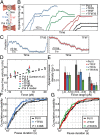Transcription factors IIS and IIF enhance transcription efficiency by differentially modifying RNA polymerase pausing dynamics
- PMID: 24550488
- PMCID: PMC3948276
- DOI: 10.1073/pnas.1401611111
Transcription factors IIS and IIF enhance transcription efficiency by differentially modifying RNA polymerase pausing dynamics
Abstract
Transcription factors IIS (TFIIS) and IIF (TFIIF) are known to stimulate transcription elongation. Here, we use a single-molecule transcription elongation assay to study the effects of both factors. We find that these transcription factors enhance overall transcription elongation by reducing the lifetime of transcriptional pauses and that TFIIF also decreases the probability of pause entry. Furthermore, we observe that both factors enhance the processivity of RNA polymerase II through the nucleosomal barrier. The effects of TFIIS and TFIIF are quantitatively described using the linear Brownian ratchet kinetic model for transcription elongation and the backtracking model for transcriptional pauses, modified to account for the effects of the transcription factors. Our findings help elucidate the molecular mechanisms by which transcription factors modulate gene expression.
Keywords: Pol II; enzyme kinetics; optical tweezers; yeast.
Conflict of interest statement
The authors declare no conflict of interest.
Figures



Similar articles
-
Transcription factors TFIIF and TFIIS promote transcript elongation by RNA polymerase II by synergistic and independent mechanisms.Proc Natl Acad Sci U S A. 2014 May 6;111(18):6642-7. doi: 10.1073/pnas.1405181111. Epub 2014 Apr 14. Proc Natl Acad Sci U S A. 2014. PMID: 24733897 Free PMC article.
-
Transcription factors IIF and IIS and nucleoside triphosphate substrates as dynamic probes of the human RNA polymerase II mechanism.J Mol Biol. 2004 Sep 24;342(4):1085-99. doi: 10.1016/j.jmb.2004.07.070. J Mol Biol. 2004. PMID: 15351637
-
Super elongation complex contains a TFIIF-related subcomplex.Transcription. 2016 Aug 7;7(4):133-40. doi: 10.1080/21541264.2016.1194027. Epub 2016 May 25. Transcription. 2016. PMID: 27223670 Free PMC article.
-
Structural basis of transcription elongation.Biochim Biophys Acta. 2013 Jan;1829(1):9-19. doi: 10.1016/j.bbagrm.2012.09.002. Epub 2012 Sep 13. Biochim Biophys Acta. 2013. PMID: 22982352 Review.
-
Basic mechanisms and kinetics of pause-interspersed transcript elongation.Nucleic Acids Res. 2021 Jan 11;49(1):15-24. doi: 10.1093/nar/gkaa1182. Nucleic Acids Res. 2021. PMID: 33330935 Free PMC article. Review.
Cited by
-
Single-molecule FRET method to investigate the dynamics of transcription elongation through the nucleosome by RNA polymerase II.Methods. 2019 Apr 15;159-160:51-58. doi: 10.1016/j.ymeth.2019.01.009. Epub 2019 Jan 17. Methods. 2019. PMID: 30660864 Free PMC article.
-
Mechanisms of backtrack recovery by RNA polymerases I and II.Proc Natl Acad Sci U S A. 2016 Mar 15;113(11):2946-51. doi: 10.1073/pnas.1517011113. Epub 2016 Feb 29. Proc Natl Acad Sci U S A. 2016. PMID: 26929337 Free PMC article.
-
Chromatin-dependent regulation of RNA polymerases II and III activity throughout the transcription cycle.Nucleic Acids Res. 2015 Jan;43(2):787-802. doi: 10.1093/nar/gku1349. Epub 2014 Dec 29. Nucleic Acids Res. 2015. PMID: 25550430 Free PMC article.
-
Critical Role of Transcript Cleavage in Arabidopsis RNA Polymerase II Transcriptional Elongation.Plant Cell. 2020 May;32(5):1449-1463. doi: 10.1105/tpc.19.00891. Epub 2020 Mar 9. Plant Cell. 2020. PMID: 32152189 Free PMC article.
-
Recent insights from in vitro single-molecule studies into nucleosome structure and dynamics.Biophys Rev. 2016;8(Suppl 1):33-49. doi: 10.1007/s12551-016-0212-z. Epub 2016 Oct 18. Biophys Rev. 2016. PMID: 28058066 Free PMC article. Review.
References
-
- Epshtein V, et al. Swing-gate model of nucleotide entry into the RNA polymerase active center. Mol Cell. 2002;10(3):623–634. - PubMed
-
- Gnatt AL, Cramer P, Fu J, Bushnell DA, Kornberg RD. Structural basis of transcription: An RNA polymerase II elongation complex at 3.3 A resolution. Science. 2001;292(5523):1876–1882. - PubMed
-
- Martinez-Rucobo FW, Cramer P. Structural basis of transcription elongation. Biochim Biophys Acta. 2013;1829(1):9–19. - PubMed
-
- Nudler E, Mustaev A, Lukhtanov E, Goldfarb A. The RNA-DNA hybrid maintains the register of transcription by preventing backtracking of RNA polymerase. Cell. 1997;89(1):33–41. - PubMed
Publication types
MeSH terms
Substances
Grants and funding
LinkOut - more resources
Full Text Sources
Other Literature Sources
Molecular Biology Databases

